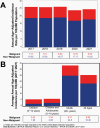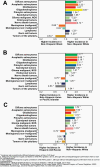CBTRUS Statistical Report: Primary Brain and Other Central Nervous System Tumors Diagnosed in the United States in 2017-2021
- PMID: 39371035
- PMCID: PMC11456825
- DOI: 10.1093/neuonc/noae145
CBTRUS Statistical Report: Primary Brain and Other Central Nervous System Tumors Diagnosed in the United States in 2017-2021
Abstract
The Central Brain Tumor Registry of the United States (CBTRUS), in collaboration with the Centers for Disease Control and Prevention and the National Cancer Institute, is the largest population-based registry focused exclusively on primary brain and other central nervous system (CNS) tumors in the United States (US) and represents the entire US population. This report contains the most up-to-date population-based data on primary brain tumors available and supersedes all previous reports in terms of completeness and accuracy. All rates are age-adjusted using the 2000 US standard population and presented per 100,000 population. Between 2017 and 2021, the average annual age-adjusted incidence rate (AAAIR) of all primary malignant and non-malignant brain and other CNS tumors was 25.34 per 100,000 population (malignant AAAIR=6.89 and non-malignant AAAIR=18.46). This overall rate was higher in females compared to males (28.77 versus 21.78 per 100,000) and non-Hispanic Black persons compared to persons who were non-Hispanic White (26.60 versus 25.72 per 100,000), non-Hispanic American Indian/Alaska Native (23.48 per 100,000), non-Hispanic Asian or Pacific Islander (19.86 per 100,000), and Hispanic persons of all races (22.37 per 100,000). Gliomas accounted for 22.9% of all tumors. The most commonly occurring malignant brain and other CNS histopathology was glioblastoma (13.9% of all tumors and 51.5% of all malignant tumors), and the most common predominantly non-malignant histopathology was meningioma (41.7% of all tumors and 56.8% of all non-malignant tumors). Glioblastomas were more common in males, and meningiomas were more common in females. In children and adolescents (ages 0-19 years), the incidence rate of all primary brain and other CNS tumors was 6.02 per 100,000 population. There were 87,053 deaths attributed to malignant brain and other CNS tumors between 2017 and 2021. This represents an average annual mortality rate of 4.41 per 100,000 population and an average of 17,411 deaths per year. The five-year relative survival rate following diagnosis of a malignant brain or other CNS tumor was 35.7%. For a non-malignant brain or other CNS tumor the five-year relative survival rate was 92.0%.
© The Author(s) 2024. Published by Oxford University Press on behalf of the Society for Neuro-Oncology. All rights reserved. For commercial re-use, please contact reprints@oup.com for reprints and translation rights for reprints. All other permissions can be obtained through our RightsLink service via the Permissions link on the article page on our site—for further information please contact journals.permissions@oup.com.
Figures
























References
-
- Louis DN OH, Wiestler OD, Cavanee WK, ed WHO Classification of Tumours of the Central Nervous System. Lyon, France: International Agency for Research on Cancer; 2016.
-
- Centers for Disease Control and Prevention (CDC). National Program of Cancer Registries Cancer Surveillance System Rationale and Approach. 1999; http://www.cdc.gov/cancer/npcr/pdf/npcr_css.pdf. Accessed July 21, 2020.
-
- Cancer Registries Amendment Act, 102nd Cong. § 515 (1992). https://www.govinfo.gov/content/pkg/STATUTE-106/pdf/STATUTE-106-Pg3372.pdf. Accessed July 21, 2020.
MeSH terms
Grants and funding
LinkOut - more resources
Full Text Sources
Medical

